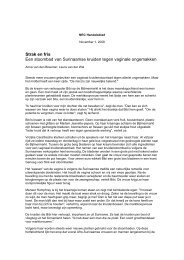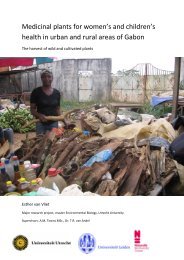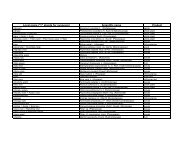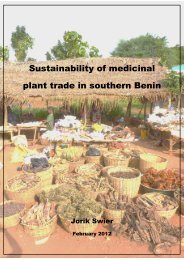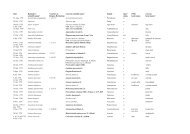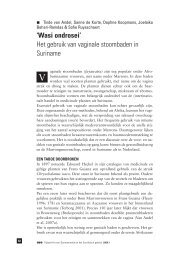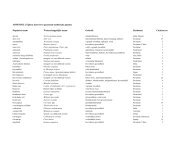T. Heilbron 2012.Botanical relics of the plantations - osodresie
T. Heilbron 2012.Botanical relics of the plantations - osodresie
T. Heilbron 2012.Botanical relics of the plantations - osodresie
Create successful ePaper yourself
Turn your PDF publications into a flip-book with our unique Google optimized e-Paper software.
(a) locations observed in <strong>the</strong> field (red dots) and collections from<br />
NHN (yellow dots)<br />
Figure 6: Phoenix reclinata<br />
(b) adult on plantation Reijnsdorp,<br />
Commewijne and fruits<br />
(Fig. 6). Wessels Boer (1965) and Ostendorf (1962) note that this clustered palm was locally<br />
frequent along <strong>the</strong> lower Commewijne river, <strong>the</strong> Suriname river and <strong>the</strong> coastal swamps near<br />
Matapica. Always encountered in a brackish environment, conditions in Suriname appear similar<br />
to <strong>the</strong> palm original habitat in Africa (Von Fintel et al., 2004). The interviews revealed that few<br />
people knew about <strong>the</strong> palm’s African origin and connection to <strong>the</strong> period <strong>of</strong> slavery. Uses<br />
encountered during fieldwork were limited. The fruits (1-2cm) are occasionally eaten, mostly<br />
by children. The fruits can be left in water overnight to enhance <strong>the</strong> ripening. Given <strong>the</strong> palm’s<br />
many uses in Africa (Kinnaird, 1992), much knowledge on this species seems to have been lost.<br />
A local banana variety (Musa x paradisiaca) was collected under <strong>the</strong> vernacular name<br />
‘loweman bakba’. This variety’s fruits have a thick angular peel (Fig. 7a). In Sranan Tongo<br />
(Surinamese language) ‘loweman’ means a runaway slave and ‘bakba’ is a term used for bananas.<br />
This plant was collected in a Javanese community on plantation Reijnsdorp. Interviews<br />
revealed that <strong>the</strong> villagers’ ancestors encountered this plant ‘growing wild in <strong>the</strong> forest’ and that<br />
<strong>the</strong> few remaining former slaves on <strong>the</strong> plantation told <strong>the</strong>m that this was <strong>the</strong> ‘loweman bakba’,<br />
that was grown by slaves and used as food during <strong>the</strong>ir escape from <strong>the</strong> <strong>plantations</strong>. Also, a<br />
collection <strong>of</strong> ‘loweman bakba’ was made from a yard in Paramaribo. The owner received this<br />
plant from a friend from <strong>the</strong> maroon village Dritabiki (Sipaliwini district in Eastern Suriname).<br />
Due to its drift seed properties, Caesalpinia bonduc occurs naturally along beaches worldwide<br />
(Rehm & Espig, 1991), including <strong>the</strong> coast <strong>of</strong> Suriname. The seeds are widely used as<br />
marbles in a game called ‘agi’ (Ewe) or ‘aware’ (Twi) in Ghana (van Andel et al., 2012). The<br />
‘agi’ game was unknown to most interviewed people, except for one man originally from Dritabiki.<br />
He told that ‘<strong>the</strong> game is still played by some elderly people, but <strong>the</strong> youth does not know<br />
this game. These seeds are known, but <strong>the</strong> game is not played with <strong>the</strong>m anymore’. Maroons<br />
use Ormosia seeds to play <strong>the</strong> ‘agi’ game nowadays (Van Andel, unpublished data).<br />
13



